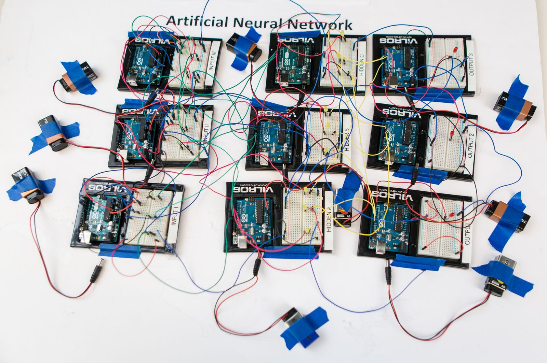Building Artificial Neural Networks with Arduinos
A 1-2 Week Curriculum Unit for High School Biology & AP Biology Classes.
In this unit, students will explore the applications of artificial neural networks, especially in the field of artificial intelligence. Students will learn about the history of artificial intelligence, explore the concept of neural networks through activities and computer simulation, and then construct a simple, three-level artificial neural network using Arduinos to simulate neurons. After building the network, they will be challenged to discover how altering the connections or programming of the “neurons” alters the behavior of the network. Finally, students will explore the ethical implications of building artificially intelligent machines.
Some of the lessons in this unit feature special equipment, including Backyard Brains’ The Claw EMG gripper hand, microcontrollers (i.e. Arduino Uno), and circuitry components (e.g., breadboards, jumper wires, resistors, photoresistors, LEDs).
The lessons were developed by Lawrence Bencivengo Jr. of Mercer Island High School (Mercer Island, Wash.) and Benjamin Hart of Redmond High School (Redmond, Wash.) as part of the 2015 CNT Research Experience for Teachers program.
Download the full PDF here. Download the PowerPoint file for Lesson Three here.
- Lesson One: Introduction to AI
- Lesson Two: Introducing Artificial Neural Networks (ANNs)
- Lesson Three: Introducing Arduinos
- Lesson Four: Building Neural Networks with Arduinos
This unit and its authors have been featured in various media. Learn more about how these teachers have engaged their biology students in learning about neural engineering, artificial neural networks, and programming using these links:
- When Science Teachers Return for Multiple Years of the CNT’s Research Experience for Teachers Program, Everyone Benefits (October 2018
- High School Teachers to Share their Neural Engineering Lesson Plans Nationally (March 2018)
- Video: The CNT Research Experience for Teachers Brings Neural Engineering to the Classroom (May 2016)
- In RET Program, Teachers Turn Summers into Science (January 2016)
This curriculum unit is also available through the Link Engineering Educator Exchange.
